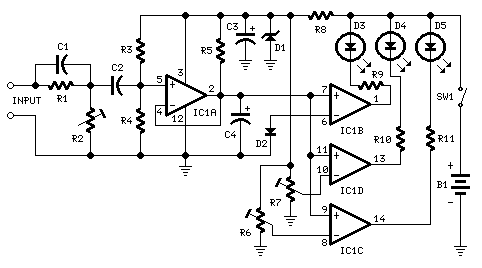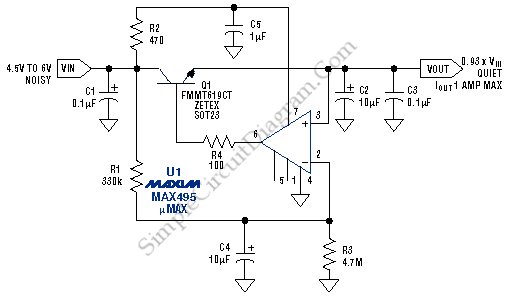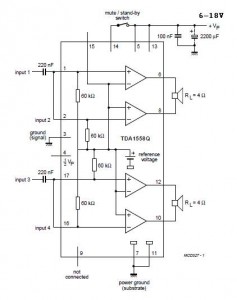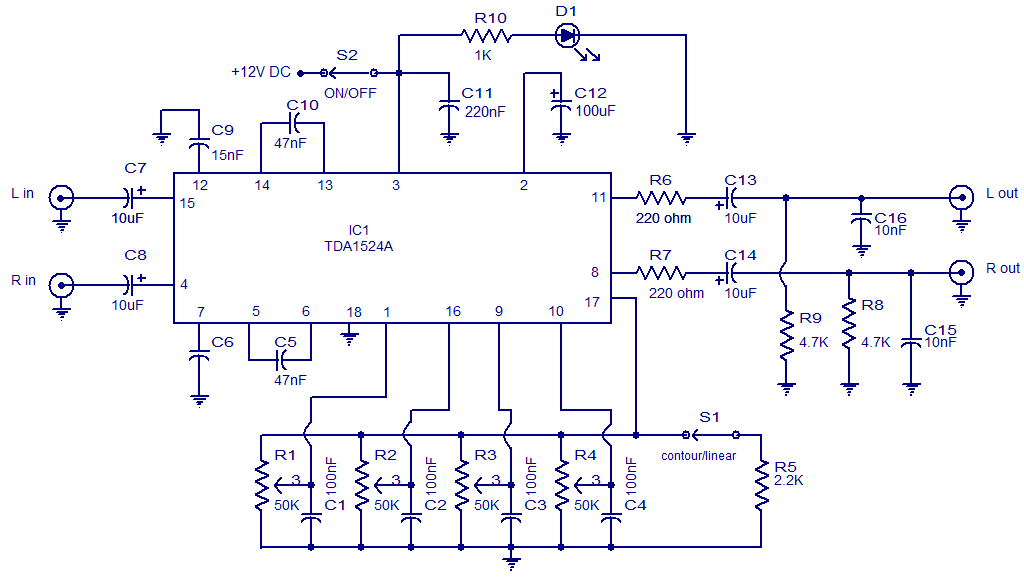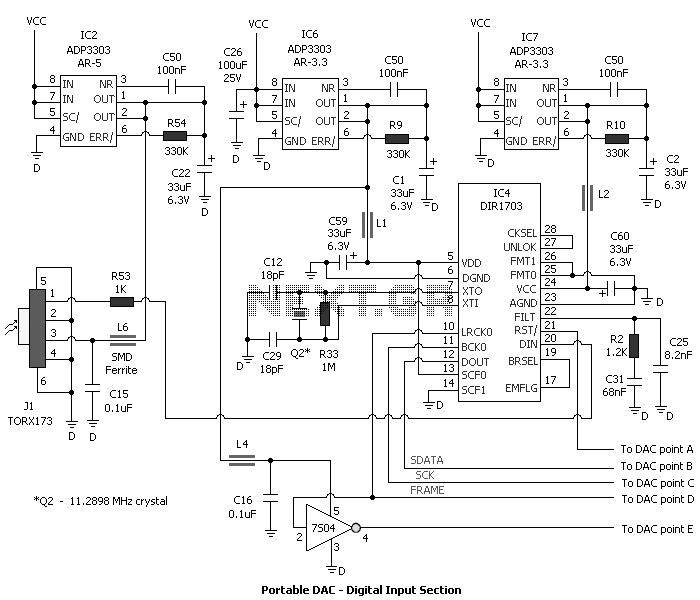
10w audio amplifier
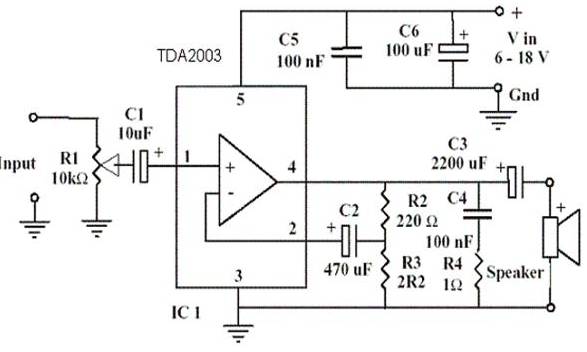
An amplifier device accepts a varying input signal and produces an output signal that varies in the same manner as the input but with a larger amplitude. The input signal can be a current, voltage, mechanical motion, or any other type of signal, while the output signal is typically of the same nature. The most common types of amplifiers are electronic, utilizing transistors or electron tubes as their principal components. Electronic amplifiers are employed in radio and television transmitters and receivers, audio and stereo systems, intercoms, and various consumer electronic devices. In their simplest form, amplifiers are constructed around a single transistor. One specific type of single-transistor amplifier, known as a common-emitter circuit, receives a varying input voltage at the base of the transistor, and the output is obtained at the collector; the ratio of the output voltage to the input voltage is termed the voltage gain. For many applications, a single transistor does not provide sufficient gain or amplification. In a cascade or multistage amplifier, the output of the first amplifying device (transistor) serves as the input to the second, whose output then feeds into the third, and so on, until adequate signal amplification is achieved. In devices such as radio receivers, multiple amplifiers enhance a weak input signal until it is strong enough to drive a speaker. Typically, multistage amplifiers are not composed of discrete components but are integrated circuits. Another, less common category of electronic amplifiers employs magnetic devices as their primary components. Additionally, various types of mechanical amplifiers exist, such as power steering systems. This audio amplifier project features a Class AB audio power amplifier utilizing a TDA2003 module. It is straightforward to assemble and requires only a few external components. The module is equipped with short circuit and thermal protection. It can drive loads as low as 1.6 ohms and is capable of delivering over 10 watts from a 16V DC power supply. The required power supply is 8-18V DC at 1 Amp or more. Maximum output power is achievable only with a power supply exceeding 1A at 16V DC and using 2-ohm speakers (or two 4-ohm speakers in parallel). However, approximately 4W RMS can be attained with a 12V DC, 1A supply into a 4-ohm load. The power supply should be well-filtered to minimize mains hum; the onboard capacitors are insufficient for this purpose but are necessary for stability. Additional filtering is not required when operating from a battery. If two boards are used for stereo applications, the power supply size must be doubled. The primary function of a printed circuit board (PCB) is to route electric currents and signals through a thin copper layer firmly bonded to an insulating base material, sometimes referred to as the substrate. This base is manufactured with an integral bonded layer of thin copper foil, which must be partially etched or otherwise removed to create a pre-designed pattern suitable for circuit connections. From the constructor's perspective, the main advantage of using a PCB is its role as mechanical support for small components, reducing the need for complex and time-consuming metalwork or chassis construction, except for the final enclosure. Most straightforward circuit designs can be easily converted into printed wiring layouts, and the thoroughness required for this conversion often highlights potential errors that might otherwise be overlooked in conventional point-to-point wiring. The completed project typically appears neater and is considered a work of art. Through proper PCB design, noise immunity can be achieved. The fabrication process of the printed circuit board significantly influences the price and reliability of the equipment. A common objective is to fabricate small series of highly reliable, professional-quality PCBs with low investment costs.
Amplifiers serve as essential components in numerous electronic applications, amplifying signals to ensure they are strong enough for further processing or output. The TDA2003 module, designed for audio amplification, exemplifies a practical implementation of amplifier technology, providing an accessible solution for audio projects. The Class AB configuration of the amplifier allows for efficient operation, minimizing distortion while delivering quality sound. The design considerations for the power supply are crucial, as they directly affect the performance and reliability of the amplifier. Proper filtering and adequate current supply are essential for optimal operation, especially when driving low-impedance loads.
In addition to audio applications, the principles of amplification can be applied to various domains, including telecommunications, instrumentation, and control systems. The integration of amplifiers into printed circuit boards facilitates compact and reliable designs, essential for modern electronic devices. The process of PCB design and fabrication must consider factors such as signal integrity, thermal management, and layout optimization to ensure high performance and durability of the final product. As technology advances, the demand for more sophisticated amplification solutions continues to grow, driving innovation in amplifier design and PCB manufacturing techniques.Amplifier device that accepts a varying input signal and produces an output signal that varies in the same way as the input but has larger amplitude. The input signal may be a current, a voltage, a mechanical motion, or any other signal; the output signal is usually of the same nature.
The most common types of amplifiers are electronic and have tr ansistors or electron tubes as their principal components. Electronic amplifiers are used in radio and television transmitters and receivers, audio and stereo systems, intercoms, and other consumer electronics devices. Amplifiers in their simplest form are built around a single transistor. In one type of single-transistor amplifier, known as a common-emitter circuit, a varying input voltage is fed to the base of the transistor, and the output appears at the transistor`s collector; the ratio of the output voltage to the input voltage is called the voltage gain.
For many purposes a single transistor does not provide sufficient gain, or amplification. In a cascade, or multistage, amplifier, the output of the first amplifying device (transistor) is fed as input to the second amplifying device, whose output is fed as input to the third, and so on until an adequate signal amplification has been achieved. In a device such as a radio receiver, several amplifiers boost a weak input signal until it is powerful enough to drive a speaker.
Usually, multistage amplifiers are not made of discrete components, but are built as integrated circuits. Another less common group of electronic amplifiers use magnetic devices as their principal components.
There are also many kinds of mechanical amplifiers, e. g. , the power steering This audio amplifier project is a class AB audio power amplifier using a TDA2003 module power amplifier. It is easy to construct and has only a few external components. The module is designed with short circuit and thermal protection. It can drive loads as low as 1. 6 ohm and is capable of delivering over 10 watts from a 16 V DC power supply. The power supply required for is 8 18V DC at 1 Amp or more. Maximum output power will only be obtained with a power supply of greater than 1A at 16V DC, and using 2 ohm speakers (or 2 by 4 ohm speakers in parallel).
However approximately 4W RMS can be obtained with a 12V DC, 1A supply into a 4 ohm load. The power supply should be well filtered to reduce mains hum, the on board capacitors alone are not adequate for this purpose but are necessary to ensure stability. Extra filtering is unnecessary if operating from a battery. If two boards are used for stereo, you will need to double the size of the power supply. The main purpose of printed circuit is in the routing of electric currents and signals through thin copper layer that is bounded firmly to and insulating base material some times called the substrata.
This base is manufactured with an integral bounded layer of thin copper foil which has to be partly etched or other wise removed to arrive at a pre-designed pattern to suite the circuit connections. From the constructors point of view the main attraction of using PCB is its role as the mechanical support for small components.
There is less need for complicated and time consuming metal work or chassis construction except perhaps in providing the [mal enclosure. Most straight forward circuit designs can be easily converted into printed wiring layout the thorough required to carry out the conversion can often highlights any possible error that would otherwise be missed in convention point to point wiring.
The finished project is usually neater and truly a work of art. Through proper design of PCB can get noise immunity. The fabrication process of the printed circuit board will determine to a large extent the price and reliability of the equipment. A common target aimed at is the fabrication of small series of highly reliable professional quality PCBs with low investment cost.
S 🔗 External reference
Amplifiers serve as essential components in numerous electronic applications, amplifying signals to ensure they are strong enough for further processing or output. The TDA2003 module, designed for audio amplification, exemplifies a practical implementation of amplifier technology, providing an accessible solution for audio projects. The Class AB configuration of the amplifier allows for efficient operation, minimizing distortion while delivering quality sound. The design considerations for the power supply are crucial, as they directly affect the performance and reliability of the amplifier. Proper filtering and adequate current supply are essential for optimal operation, especially when driving low-impedance loads.
In addition to audio applications, the principles of amplification can be applied to various domains, including telecommunications, instrumentation, and control systems. The integration of amplifiers into printed circuit boards facilitates compact and reliable designs, essential for modern electronic devices. The process of PCB design and fabrication must consider factors such as signal integrity, thermal management, and layout optimization to ensure high performance and durability of the final product. As technology advances, the demand for more sophisticated amplification solutions continues to grow, driving innovation in amplifier design and PCB manufacturing techniques.Amplifier device that accepts a varying input signal and produces an output signal that varies in the same way as the input but has larger amplitude. The input signal may be a current, a voltage, a mechanical motion, or any other signal; the output signal is usually of the same nature.
The most common types of amplifiers are electronic and have tr ansistors or electron tubes as their principal components. Electronic amplifiers are used in radio and television transmitters and receivers, audio and stereo systems, intercoms, and other consumer electronics devices. Amplifiers in their simplest form are built around a single transistor. In one type of single-transistor amplifier, known as a common-emitter circuit, a varying input voltage is fed to the base of the transistor, and the output appears at the transistor`s collector; the ratio of the output voltage to the input voltage is called the voltage gain.
For many purposes a single transistor does not provide sufficient gain, or amplification. In a cascade, or multistage, amplifier, the output of the first amplifying device (transistor) is fed as input to the second amplifying device, whose output is fed as input to the third, and so on until an adequate signal amplification has been achieved. In a device such as a radio receiver, several amplifiers boost a weak input signal until it is powerful enough to drive a speaker.
Usually, multistage amplifiers are not made of discrete components, but are built as integrated circuits. Another less common group of electronic amplifiers use magnetic devices as their principal components.
There are also many kinds of mechanical amplifiers, e. g. , the power steering This audio amplifier project is a class AB audio power amplifier using a TDA2003 module power amplifier. It is easy to construct and has only a few external components. The module is designed with short circuit and thermal protection. It can drive loads as low as 1. 6 ohm and is capable of delivering over 10 watts from a 16 V DC power supply. The power supply required for is 8 18V DC at 1 Amp or more. Maximum output power will only be obtained with a power supply of greater than 1A at 16V DC, and using 2 ohm speakers (or 2 by 4 ohm speakers in parallel).
However approximately 4W RMS can be obtained with a 12V DC, 1A supply into a 4 ohm load. The power supply should be well filtered to reduce mains hum, the on board capacitors alone are not adequate for this purpose but are necessary to ensure stability. Extra filtering is unnecessary if operating from a battery. If two boards are used for stereo, you will need to double the size of the power supply. The main purpose of printed circuit is in the routing of electric currents and signals through thin copper layer that is bounded firmly to and insulating base material some times called the substrata.
This base is manufactured with an integral bounded layer of thin copper foil which has to be partly etched or other wise removed to arrive at a pre-designed pattern to suite the circuit connections. From the constructors point of view the main attraction of using PCB is its role as the mechanical support for small components.
There is less need for complicated and time consuming metal work or chassis construction except perhaps in providing the [mal enclosure. Most straight forward circuit designs can be easily converted into printed wiring layout the thorough required to carry out the conversion can often highlights any possible error that would otherwise be missed in convention point to point wiring.
The finished project is usually neater and truly a work of art. Through proper design of PCB can get noise immunity. The fabrication process of the printed circuit board will determine to a large extent the price and reliability of the equipment. A common target aimed at is the fabrication of small series of highly reliable professional quality PCBs with low investment cost.
S 🔗 External reference
